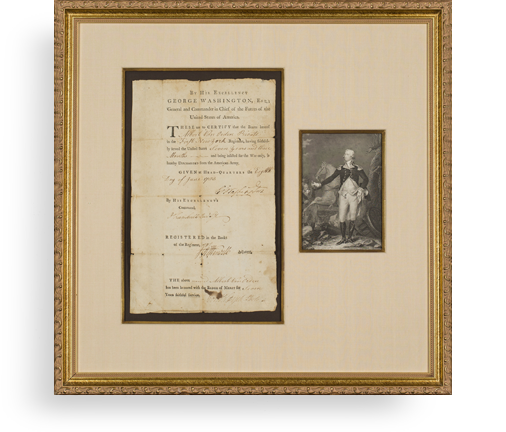Philip II, As King of England, Appoints a Soldier of His Father, Emperor Charles V, to Command a Unit Against the French in the Habsburg-Valois Conflict

A rare letter of Philip rallying his troops during the great Italians Wars, mentioning “The Emperor,” and signed as King of England.
Charles V, also known as Charles I of Spain, was Duke of Burgundy and ruler of the Netherlands from 1506, ruler of the Spanish Empire from 1516 and Holy Roman Emperor from 1519, until he voluntarily stepped down from these and other positions by a series of abdications between 1554 and 1556....
Charles V, also known as Charles I of Spain, was Duke of Burgundy and ruler of the Netherlands from 1506, ruler of the Spanish Empire from 1516 and Holy Roman Emperor from 1519, until he voluntarily stepped down from these and other positions by a series of abdications between 1554 and 1556. Through inheritance, he brought together under his rule extensive territories in central, western, and southern Europe, and the Spanish colonies in the Americas and Asia. As a result, his domains spanned nearly four million square kilometers, and were the first to be described as “the empire on which the sun never sets”. Charles was the heir of three of Europe’s leading dynasties: the Houses of Habsburg, Valois-Burgundy and Trastámara. From his own dynasty, the Habsburgs, he inherited Austria and other lands in central Europe. He was also elected to succeed his Habsburg grandfather, Maximilian I as Holy Roman Emperor, a title held by the Habsburgs since 1440.
Charles was only 56 when he abdicated, but after 34 years of energetic rule he was physically exhausted and sought the peace of a monastery where he died at the age of 58. On Charles’s abdications, the title of Holy Roman Emperor passed to his younger brother Ferdinand (who had already been given the Austrian lands in 1521) and the Spanish Empire, including the possessions in the Netherlands and Italy, was inherited by Charles’s son Philip II. The two empires would remain allies until the 18th century.
From 1554, Philip was King of Naples and Sicily as well as Duke of Milan. After his marriage to Queen Mary I in 1554 he was also King of England and Ireland. From 1555, he was also lord of the Seventeen Provinces of the Netherlands.
Charles reign was characterized by continual war, and Philip inherited among the most consequential of these, the Habsburg-Valois conflict. This began when Henry II of France, who had succeeded Francis I to the throne, declared war against Charles with the intent of recapturing Italy and ensuring French, rather than Habsburg, domination of European affairs. This conflict dragged on for 60 years, and culminated in the Italian Wars.
In 1555, seeking to end this conflict, Philip appointed Duke of Alva as Governor of Milan and Commander in Chief of his Italian forces. Pedro de Silva was the son of the conquistador and a young aspiring commander, and Philip, with this letter, sent him to join Alva’s forces in the fight against the French.
Letter signed in the Spanish style “Yo el Rey” – I the King, Hampton Court, June 2, 1555, with Philip’s paper seal, to the Duke of Alva, Commander in Chief of the Imperial Forces in Italy. The text is in Spanish, and in the fine italic hand of Secretary of State Gonzalo Perez and countersigned by him as well. “Don Philippe by the grace of God, King of England, of Naples, etc… Prince of Spain, Duke of Milan, etc….” To the “First Duke, Governor of the State of Milan, Deputy and Captain General. You will already have heard of Don Pedro de Sylva… who has risen in my service, after having completed his service for the Emperor, my señor, in the war… It is my desire… and he has requested, that he be sent to raise an infantry company…”
Shortly hereafter, Silva, a young and promising soldier of the King, was killed in battle.
Letters of Philip as King of England, a post he held for only 4 years, are very rare.

Frame, Display, Preserve
Each frame is custom constructed, using only proper museum archival materials. This includes:The finest frames, tailored to match the document you have chosen. These can period style, antiqued, gilded, wood, etc. Fabric mats, including silk and satin, as well as museum mat board with hand painted bevels. Attachment of the document to the matting to ensure its protection. This "hinging" is done according to archival standards. Protective "glass," or Tru Vue Optium Acrylic glazing, which is shatter resistant, 99% UV protective, and anti-reflective. You benefit from our decades of experience in designing and creating beautiful, compelling, and protective framed historical documents.
Learn more about our Framing Services








































































































